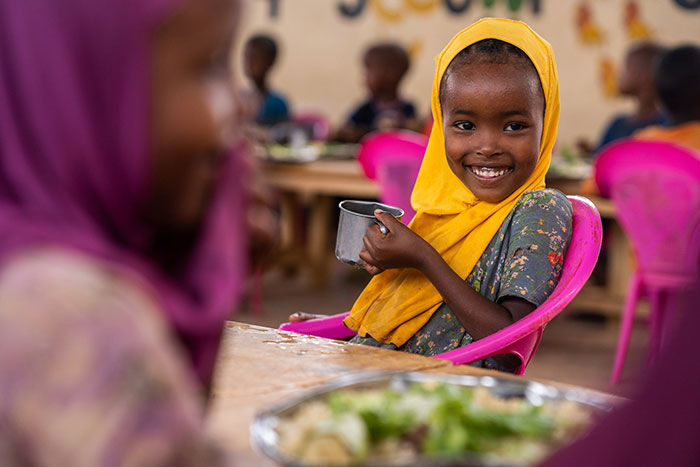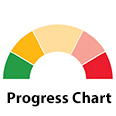Zero hunger

A girl enjoys lunch with her friends at Kabasa Primary School in Dollow, Somalia. Supported by UNICEF, the school offers students clean water and healthy meals.
© UNICEF/Zerihun SewunetStubborn hunger trends underscore urgent need for scalable, financed solutions
Global hunger levels, measured by the prevalence of undernourishment, remained at the same level for three consecutive years after a sharp rise during the pandemic. In 2023, hunger affected 9.1 per cent of the global population (between 713 and 757 million people), up from 7.5 per cent in 2019. Sub-Saharan Africa was the region with the highest hunger rate, with 23.2 per cent of the population facing hunger, while Southern Asia remained home to the largest number of people facing hunger, 281 million. Moreover, 2.33 billion people globally experienced moderate or severe food insecurity in 2023; this is 383 million more than in 2019.
These persistently high levels of global hunger, food insecurity, and malnutrition are driven by conflict, climate variability and economic instability, which are further compounded by challenges such as inequalities and lack of access to food. Addressing these driving factors – growing in both intensity and frequency – requires scalable solutions backed by adequate and sustained financing.
Prevalence of undernourishment, 2021-2023 (percentage)

* Excluding Australia and New Zealand.
Image coming.
Global progress on child malnutrition is slowing, with signs of reversal
Malnutrition continues to undermine children’s growth, development and long-term health. Between 2012 and 2024, the prevalence of stunting (low height-for-age) among children under age 5 decreased from 26.4 to 23.2 per cent. However, recent data indicate a potential reversal of this progress. Stunting remains particularly pronounced in low- and lower-middle-income countries, where 86.8 per cent of the 150 million stunted children reside. In 2024, the prevalence of stunting was higher among boys (24.4 per cent) than girls (21.9 per cent). Meeting the 2030 target of halving the stunting rate will require a sharp acceleration in efforts.
The global prevalence of being overweight (high weight-for-height) among children under age 5 rose marginally from 5.3 to 5.5 per cent between 2012 and 2024, but this is not statistically significant. The global prevalence of wasting (low weight-for-height) declined from 7.4 to 6.6 per cent during this period, with notable declines in the number of children experiencing wasting in Central and Southern Asia (by 16 per cent) and sub-Saharan Africa (by 5 per cent). Still, these two regions account for over 80 per cent of all children globally affected by wasting (57.5 per cent in Central and Southern Asia and 23.8 per cent in sub-Saharan Africa).
Proportion of children under age 5 living with stunting, wasting and being overweight, 2012–2024 (percentage)

Note: Shaded areas represent confidence intervals of 95 per cent.
Anaemia and inadequate diet diversity remain major barriers to global nutrition goals for women and children
Anaemia (which impairs birth outcomes, productivity and cognition) globally affected 30.7 per cent of women aged 15–49 years in 2023, up from 27.6 per cent in 2012. Its prevalence among pregnant women remains steady at 35.5 per cent, while rates among non-pregnant women slightly increased from 27.1 to 30.5 per cent between 2012 and 2023. Reaching the 2030 goal of a 50 per cent reduction will require faster, cross-sectoral action.
Minimum dietary diversity is essential for the adequate intake of vitamins and minerals. Globally, only two thirds (65 per cent) of women aged 15–49 years attained minimum dietary diversity between 2019 and 2023. Sub-Saharan Africa (44 per cent) and Central and Southern Asia (48 per cent) had the lowest rates, while Eastern and South-Eastern Asia (84 per cent) and Europe and Northern America (79 per cent) had the highest rates. For children aged 6–23 months, dietary diversity remains critically low. About 34 per cent met the standard between 2016 and 2022, up from 28 per cent between 2009 and 2015. Sub-Saharan Africa (23 per cent) and Central and Southern Asia (27 per cent) are particularly affected.
Proportion of women aged 15–49 years and children aged 6–23 months that achieved minimum dietary diversity, latest data (percentage)

* Excluding Australia and New Zealand.
Note: Data for women aged 15–49 are from 2019–2023; data for children aged 6–23 months are from 2016–2022.
Small-scale food producers typically earn and produce less, yet they are essential for agrifood resilience
Small-scale food producers are essential for resilient agriculture, food security and the fight against hunger, yet they remain highly vulnerable within agrifood systems. Their labour productivity is consistently lower than that of larger producers, especially in developed countries, where it often falls below 25 per cent that of large-scale producers. Income gaps between small-scale and larger food producers remain wide. In most countries, small-scale producers earn less than $1,500 annually (2017 PPP), and in some cases, under $500 – often less than half the earnings of larger producers. The gender gap varies across countries. In most countries with available data, male-headed production units report higher average incomes than female-headed units, while in labour productivity, the gap is not so evident.
Global agricultural investment reaches record highs, but the sector remains underfunded
Global public expenditures on agriculture reached a record high of $701 billion in 2023, reflecting a 2 per cent average annual growth since 2015. However, agriculture accounted for only 1.85 per cent of total government spending. The agriculture orientation index (AOI) – government expenditure on agriculture relative to the sector’s GDP contribution – fell from 0.50 in 2015 to 0.43 in 2023. LDCs and LLDCs allocate 4 per cent of total government expenditure to agriculture despite the sector generating approximately 18 per cent of their GDP. The AOI in LLDCs decreased from 0.26 in 2015 to 0.19 in 2023, while LDCs showed marginal improvement from 0.20 to 0.21 over the same period.
Meanwhile, aid for agriculture to developing countries fell slightly by 2.5 per cent in 2023 after peaking in 2022. But the total volume increased by 43.5 per cent, from $12.9 billion in 2015 to $18.5 billion in 2023 (constant 2023 prices). Support to Africa reached a historical peak in 2023, with an increase of 3.8 per cent compared to 2022.
Pressures ease for global food prices, but they remain triple pre-pandemic levels
In 2023, approximately 50 per cent of countries experienced moderately to abnormally high food prices; this is a moderate decline from 2022’s record of 60 per cent, but it is three times the 2015–2019 average of 16 per cent. This decrease was largely driven by reductions in shipping costs and in fuel and fertilizer prices, particularly during the first half of 2023.
While most regions experienced price improvements, Eastern and South-Eastern Asia saw the proportion of countries with high food prices double in 2023, returning to 2020 levels. This was fuelled by rising rice prices amid weather-related production concerns, stockpiling and trade restrictions. SIDS also saw food-price pressures worsen for a second consecutive year in 2023, owing to persistent food-price inflation.
Proportion of countries affected by moderately to abnormally high food prices, 2015–2019 average and 2023 (percentage)


